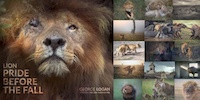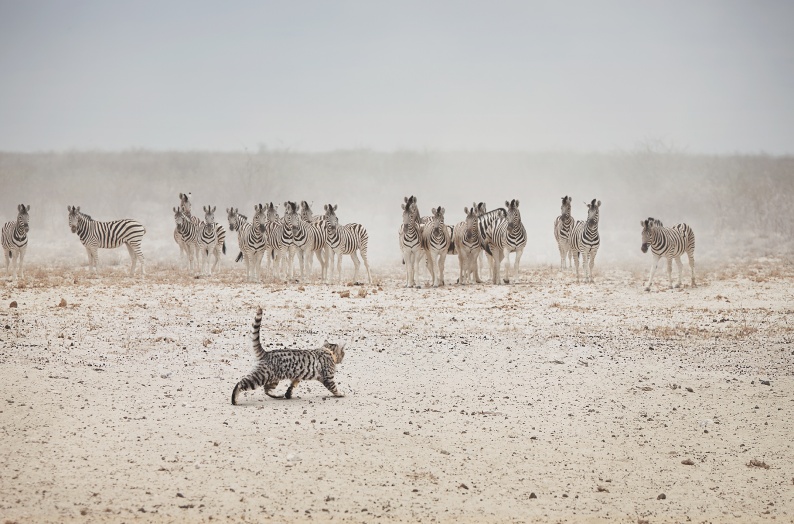News
FOCUS: George Logan
18 November 2020

© George Logan
The highly anticipated landmark photographic book Lion: Pride Before The Fall skilfully captured by George Logan is here! You may remember or have indeed supported the kickstarter campaign back in July. Celebrating the lifecycle of the African Lion in all its natural beauty, drama and raw ferocity, the book highlights the fight to protect the last remaining wild African Lions… or risk losing them forever. We catch up with George to find out more about the project, how he came to photograph Lions in the wild and just how close he dares to get to these iconic creatures!

© George Logan. Lion: Pride Before The Fall
How did you embark on your inspirational career as a photographer?
I started taking pictures, aged 14. I originally wanted to be a reportage photographer, so I used to head out to cover political marches, music gigs and shoot street photography.
At photography college in Blackpool, I realised my skill set lay in another direction. I loved using my imagination to create more conceptual and often abstract imagery.
The fascination with photographing wild animals came later.

© George Logan
Following the success of your Kickstarter of the landmark photographic book, Lion: Pride before the fall. Can you tell us how the project came about?
I wanted to create a project where my photography really meant something, had an impact and effected positive change. I’ve been documenting lion prides all across Africa, so I had in mind a book. When the Born Free Foundation approached me to collaborate on this project, I knew it was something I really needed to do.
Each time I go to Africa, I see fewer lions and it’s tragically apparent that the wild places are shrinking rapidly, so I’ve been focussing all my efforts on doing what I can to help slow the race to extinction for many of our iconic species.

© George Logan - Whiskas Campaign
Why Lions? Where does your fascination come from?
My fascination with lions began when, as a very young child, I saw the film Born Free and was instantly transported. Now, I’m borderline obsessive. I can watch lions all day, with or without a camera.
I’m never happier than when heading out in to the African dawn to discover what the pride have been up to in the night and what dramas have unfolded.
But as my fascination grew, so did my awareness that we are losing lions at an alarming rate. In my lifetime, their numbers have dropped from approx. 100,000 to less than 20,000. At the current decline, they will be gone from the wild by the middle of this century.
So, I wanted to put together my best possible collection of lion imagery, create a book and direct all the profits towards helping protect and save the last remaining wild lions. For this project we are concentrating our efforts on protecting and re-establishing the Last Lions of Meru, in Kenya, where less than 70 remain.

© George Logan - Ikea
Were there any ‘close encounters’ in the making of the book?
I am regularly asked this, and it’s true that there are many ‘close encounters’. We shoot with a film vehicle with no doors, so we can get great low angles. The lions do get curious and come up VERY close…touching distance even, but for whatever reason they don’t see us as prey.
Very occasionally, we get mock-charged, where they are basically just seeing you off …and there are several lions which we know not to get too close to, but generally it’s ok, not too terrifying and makes for some great shots.

© George Logan. Lion: Pride Before The Fall
Do you only photograph wild animals in their natural habitat?
Yes. They do not belong in film or photo studios, exploited as exotic props or passed off as fine art photography.
Very early in my career, I was commissioned to photograph a zebra in a studio. The poor creature was stressed and traumatised, even though it had come via one of the big reputable animal hire companies. It was such a grim experience that I promised myself that it would never happen again.
Over the years, this decision has lost me many commissions, as I always refuse to photograph any wild animal under unnatural studio conditions. Having photographed countless animals where they belong, in the wild, I can promise you there is no comparison between the demeanour and behaviour of a wild and free animal to that of their unfortunate, captive cousins.
It's hard to believe that it’s still perfectly legal to hire a captive lion and take pictures for your adverts or project, without consideration for where that animal has come from or how it is being kept. We need to be better than this.
You don’t only specialise in animal photography, can you tell us about your other commissioned work?
Yes, my day job is shooting commissioned advertising. I love being involved at an early stage and contributing to the creative process.
I’ve worked on some incredible campaigns and photographed in some of the most amazing, remote locations in the world.
What would you say to anyone considering joining the AOP?
Do it. The AOP is the only photo organisation I’ve ever been a member of.
Over the years I’ve benefitted from superb legal advice, helped to put on exhibitions and of course, the Awards.
It’s also a brilliantly helpful community and I’d definitely encourage all photographers to join.
Buy the book and visit the Lion: Pride Before The Fall dedicated website
Visit the Born Free Website
View George's profile in Find a Photographer here
View a selection of the images from Lion: Pride Before The Fall in Spotlight
www.georgelogan.co.uk



